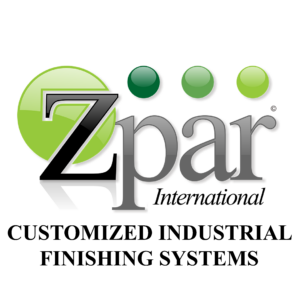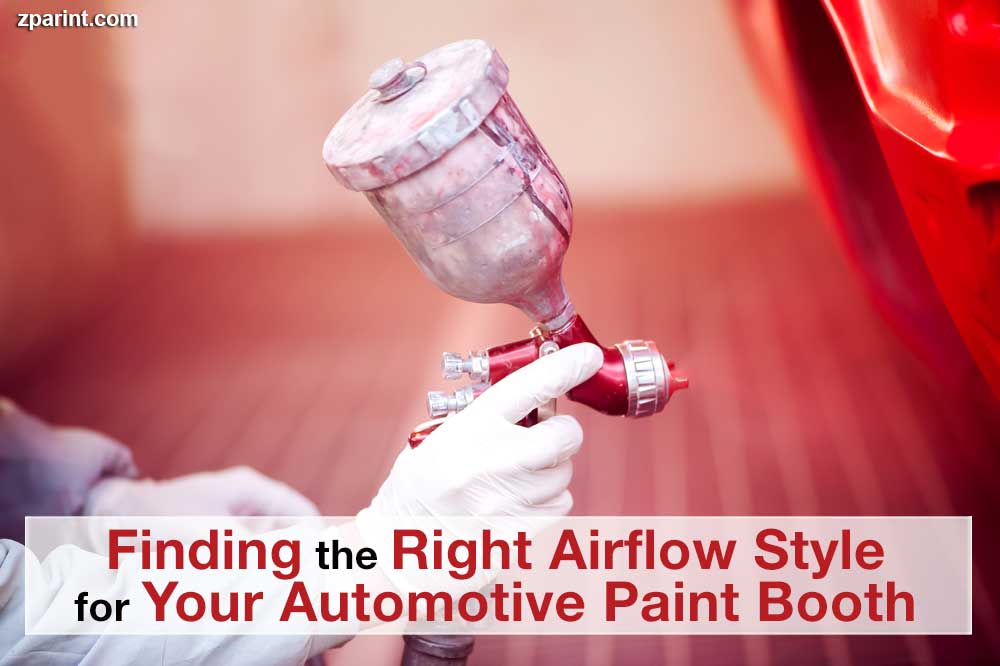You’ve finally decided to invest in a paint booth for your automotive shop. Congratulations! This is an excellent choice when it comes to making sure the whole body of the cars you work on features an even and professional-looking finish. It will as well guarantee you can boost the overall efficiency and productivity of your painters. While at the same time ensuring you do your part in conserving the environment and minimize health and safety risks to your painters.
However, now you’ve made the decision to invest in a spray booth, the next critical factor is undoubtedly choosing the most suitable airflow style for your paint job operations. The airflow style you eventually settle for will prove to be one of the most significant variables in the context of the finish quality of your automobile paint booth and even reducing the risk of contamination. The best airflow style will also determine the ultimate cost for the unit you invest in and even the overall operational costs of running your paint facility. Well then, here is a review of the 4 most common airflow styles for automotive paint jobs.
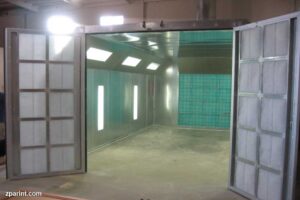 The Cross-Flow paint booth
The Cross-Flow paint booth
The cross-flow paint booth is one of the most cost-effective airflow solutions for automakers and is in widespread demand in this given industry. Such units are noted for operating at low airflow rates, which means they can function pretty well with small fans and air makeup units along with less filters. All of these factors make the crossflow airflow style a more pocket-friendly upfront solution and can even substantially minimize an automotive paint booth operational costs. In this configuration, airflow is introduced horizontally into the booth via a wall-mounted plenum or a filtered door, and is relayed to a wall-mounted exhaust plenum. There are also filter banks that capture particles and the filtered air is dispelled into the atmosphere via ducting. Besides its budget-friendly aspect, the cross flow spray booth may be pressurized to facilitate climate control functionality, which makes it appealing for carmakers. These varieties of units are as well a highly versatile option when it comes to the wide range of different items that can be finished in them. On the downside, one of the greatest disadvantages of a cross flow paint booth is inefficient overspray and contamination control. Generally, overspray can always be drawn across the unit, pushed in the direction of the airflow. In most cases than not, this may contaminate both unpainted and painted surfaces.
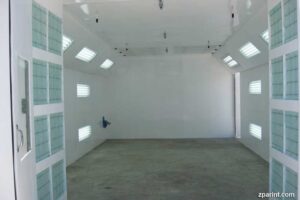 The Semi Downdraft paint booth
The Semi Downdraft paint booth
A semi downdraft automotive paint booth is a cross between a crossflow and downdraft booth, and blends the functionalities of both of them. Semi downdraft units are noted for being more affordable than the downdraft varieties and necessitate lesser overall operational costs. In this kind of booth, air is drawn from the supply filters in a downward direction and is ultimately expelled through wall mounted exhaust plenums located at the right and left lower walls. This sort of spray booth can replicate the performance of pitted downdraft booths less the necessity to install a concrete pit. Also, semi downdraft booths deliver a better overspray control upon comparison with the downdraft types. On the other hand, the only disadvantage of these units is their airflow isn’t laminar all across the booths. This implies dead spots or eddy currents can make the paint application process rather tedious even for skilled and seasoned painters.
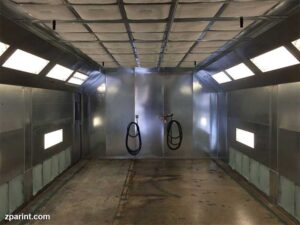 The Side Downdraft booth
The Side Downdraft booth
This sort of paint booth can prove to be a very affordable solution for automakers who, for one reason or the other, can’t install exhaust pits in their units. The installation of exhaust pits is both a time-consuming and costly proposition. In the non-pressurized configuration, air is introduced within the unit in a downward direction over the object being painted via full length and filtered ceiling fans situated on both sides of the booth. For pressurized units, air makeup units or intake fans drive the air towards an intake plenum enclosing the full length and filtered ceiling.
One of the key advantages of such an automotive paint booth is it delivers a more even airflow, particularly when contrasted with the crossflow variety. Additionally, it presents a greater level of contamination control than the latter. The quality of its finish is as well superior to the crossflow booth due to the downward airflow direction and side exhaust. On the downside, the side downdraft spray booth necessitates a large footprint to accommodate more exhaust fans, plenums, ducting and roof penetration. All of which significantly increases the width of such units. In terms of operational costs, the side downdraft booth is more economical thanks to its full ceiling filtration process.
The Pitted Downdraft booth
When compared with the other paint booths reviewed here, the pitted downdraft paint booth delivers the finest airflow style for the control of overspray and even contamination. In this configuration, air is introduced into the unit via a filtered ceiling plenum and moves in a vertical and downward direction over and above the car being painted. It is finally expelled via a filtered exhaust that is situated beneath the floor. This pit encompasses almost the whole length of the unit. When contrasted with the side downdraft booths, airflow in a pitted downdraft spray booth isn’t impeded by gravity, but rather helped by it to relay overspray into the pit. One of the greatest advantages of these units is their airflow delivers very few blemishes and therefore necessitates few touch-ups. On the flipside, this variety of automotive paint booth needs around 20% to 40% more air than the crossflow booth, which increases its operational costs. Yet, your business can effortlessly recoup the cost of purchasing top of the line equipment in less than 12 months due to heightened throughput and labor costs savings as a result of a decreased demand for cutting and buffing.
All in all, the choice of the right airflow style for a paint booth ties in to budget. Additionally, the argument that the pitted and side downdraft airflow units being the best since air moves the least distance across the surface of the object being painted is a myth. The greatest advantage of these sorts of spray booths is they can allow multiple painters to work simultaneously with little effect on each other’s operations. When all is said and done, this is what can determine your solution of choice if budget isn’t a factor. No matter your budget, ZPar International is here to meet your needs. Give us a call and let’s find the perfect solution for you!
